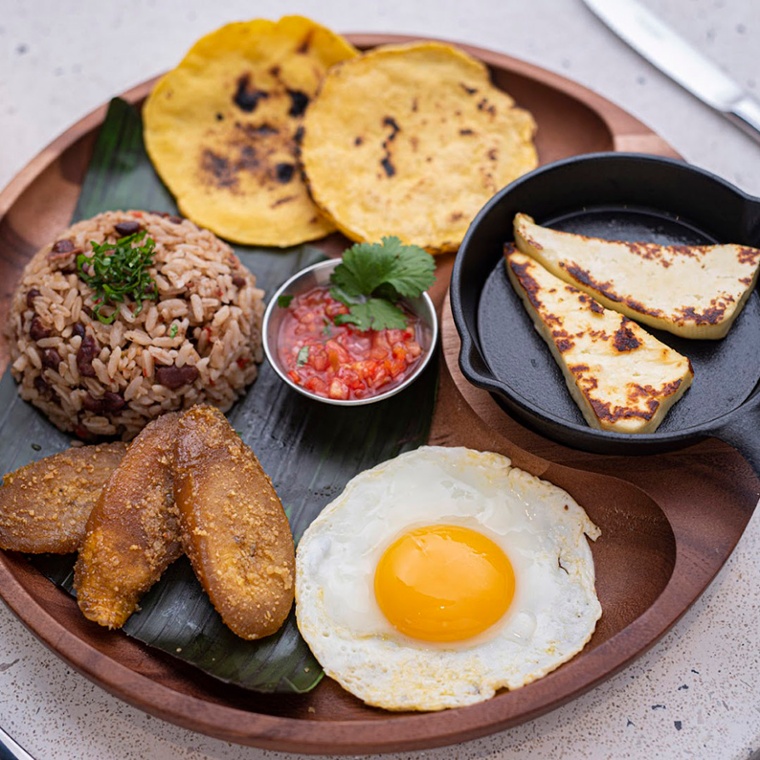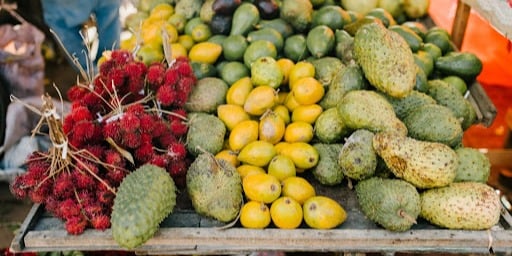The Flavors of Costa Rican Cuisine- Simple, Sweet and Savory

When my husband and I decided to visit Costa Rica, I was a little worried. Not about safety (Costa Rica is the safest of the Central American Countries), or about the strangeness of a new home...but about the food.
I know, that sounds like a weird thing to worry about, but I’m REALLY wimpy when it comes to spices. Previous trips to Mexico, Jamaica and the Dominican Republic had taught me to be really leery of heavily spiced foods.
I knew that it’s common for many cultures in hot climates to eat spicy foods, and I assumed that it might be hard for me to enjoy the local cuisine. In Mexico, we stayed at an all-inclusive resort and the nearest restaurant had a limited menu. By the middle of the week I had tried several meals that I just couldn’t eat. I ate the same two or three items over and over for the rest of our stay.
Well, rest assured. Now that I’ve been in Costa Rica for a while, I can honestly say Costa Rican food is not unbearably spicy, and it’s fantastic!
What Does A Typical Costa Rican Diet Look Like?
The standard diet is fairly simple, and really quite healthy.
The staples are rice and beans (mixed together and known as Gallo Pinto), fruits and veggies, fish and meats. Where at home we tend towards a lot of wheat breads, here they lean more towards corn based breads like tortillas.
Authentic Costa Rican cuisine is uncomplicated, uses whatever fresh ingredients are near to hand and is meant to be shared. Meals are social occasions, often prepared as a group and savoured slowly with much laughter and probably music.

If you wander into any local restaurant (referred to as a “soda”) you will generally find a buffet-type set up. To go truly authentic you would order what’s called a casado. Depending on the size you order, you will be able to choose from a variety of side dishes including the standard gallo pinto, grilled Costa Rican vegetables, and meats, cold salads, grilled plantain (one of the most famous Costa Rican fruits), and pico de gallo.
The flavours are relatively simple. Meats are usually grilled but also appear in rich sauces. I was surprised to find that grilled plantains are served with almost everything, and that they (known as maduros) are really sweet. Cilantro is extremely common.
A wide variety of fish and seafood are available everywhere. Costa Rica has some of the best deep-sea fishing anywhere, so in many cases the fish is caught and served the same day. Octopus (known in Spanish as Pulpo) is a really common dish, but not one that I’ve tried here. (I’m working up to it!)
Traditional Costa Rican Dishes
Here are some of the most common local dishes. I've made each title a link so you can check out a recipe and try it for yourself.
When I arrived, I would often hear people talking about rice and beans. I foolishly assumed they were two separate items, and you do find plain rice and beans on many menus. Normally though, when they say “rice and beans”, they are talking about Gallo Pinto, which many of my tico friends consider the very best food in Costa Rica.

Those of you who know Spanish will realize that this translates to “spotted rooster”. WHY? I have no idea. Gallo pinto is a vegetarian dish and is often served with a side of eggs, some fruit and soft cheese as a traditional breakfast. In fact, the term used to describe a standard breakfast here IS “gallo pinto.”
While gallo pinto is a standard menu item in many Latin American countries, I’m told true Costa Rican gallo pinto must include Salsa Lizano. As a reference, it’s kind of like worcestershire sauce with a touch of cumin.
A typical recipe includes rice, beans, lizano, red peppers, onion, garlic and cilantro.
***Guests of The Ocotea Hotel can enjoy a complimentary breakfast of gallo pinto in the Nectandra Restaurant. It’s made with love, and it’s fantastic!
Most people are probably familiar with this dish. In North America it’s served as a side with tortillas or nachos. Here it’s served with many meals and eaten as we would coleslaw (although coleslaw is also a common side).

Plantains are as much a part of Costa Rican cuisine as corn. They are served in lots of different ways but the most common seems to be as patacones or as maduros.
Patacones are made from green plantains which are savory and starchy. They are served with guacamole, refried beans, pico de gallo or natilla (the local version of sour cream).

Maduros are made by frying ripe plantains and are sweet and sticky.

And both are tasty!
This dish is found absolutely everywhere, and with good reason. Served by itself in a cup or with tortilla chips, it can be made from many different types of fish and seafood. The raw fish is diced and marinated in lime juice rather than cooked over heat.
This is a brand new dish that is taking the country by storm. It starts with a bag of seasoned corn chips, so it’s a handy stack for picnics and road trips.
You cut the top of the bag, drop in some of your favourite ceviche and top it off with salsas (sauces) or hot sauce. The topping of choice for most ticos is ketchup and mayonnaise (which also goes on french fries).
To be truly authentic Picaritas, Ranchitas or Jalapeños brand chips should be used.
The term “caldosa” means “having broth”, so the ceviche used for this tasty treat is juicier than usual, so the chips soak up all the extra flavour from the ceviche.
Since I’m not a fan of spice, I was quite excited to discover mango salsa! It’s absolutely delicious and when made with mangoes fresh off the tree (one of my favorite native Costa Rican fruits), it’s hard to beat.
Mango salsa is most commonly served as a side with various white fish dishes, but I’m just as happy scooping it up with a tortilla and stuffing it in my face. I highly recommend pairing this with a frozen mango daiquiri!
Arroz con pollo (And a Whole Lot More!)
This dish is actually available in a wide variety of options. I generally choose “Con Pollo” because for whatever reason, the chicken you buy here is sweet and juicy and huge, so I know it’s going to be delicious. Arroz con Camarones (shrimp) would be my next choice.
The chicken or fish, etc. is boiled to create a broth and the broth is then used to cook the rice, resulting in a tasty, hearty meal full of flavour. Seeing a theme?
I learned about Picadillo in a really weird way. One of the men who maintain the grounds at my condo showed up at my door one day. He was carrying a bag full of takeout containers and offered me one for “dos mil”, which is a little more than 3 dollars. I should mention that Francisco speaks no English, and at the time I spoke very little Spanish. When I asked “Que esta?” and he answered “Picadillo”, I was intrigued. The smell emanating from the dish was amazing but I thought it prudent to ask “Esta Picante?” (Is it spicy?)
He smiled and shook his head. I decided to be brave and bought 2. My husband took one look and chickened out, so I ended up with two containers of Picadillo all to myself.
I ate my way through it, poking at things here and there and trying to identify what each was. Francisco’s version had bits of shrimp and chicken, rice, and lots of veggies. The one thing I couldn’t identify was white and almost clear and tasted a lot like yucca. I eventually found out it was chayote.
But despite my apprehension, it was delicious, and I’ve got to recommend it! I quite enjoyed my picadillo, and every so often Francisco brings me more. The recipe that I have linked is made with chayote too, but it is more common to use ground beef.
The best comparison I can use is that picadillo is like a North American hash, which makes sense because “picar” means “to chop or mince” in Spanish.
This dish most closely resembles a corn pancake, and that’s just about what it is! But unlike pancakes, it is eaten for breakfast or as an afternoon snack, and is usually more savory — often coming with a dollop of natilla (sour cream)on top. It reminds me of the potato pancakes or latkes that I love from home, and they’re such a fun snack!
Tamales are basically little bundles of love steamed inside banana leaves or corn husks. (Mexicans traditionally use corn husks but Ticos use banana leaves.The leaves are then used as plates)
Just like in other countries that have this tasty treat, making tamales is generally a family affair and the recipes vary widely depending on what’s available and the individual family recipe. The link takes you to a recipe but there is also a video on the page that shows the process behind making them if you’re interested.
What’s really cool is that in learning about tamales, I unknowingly stumbled upon the fact that they’re a Costa Rican Christmas Tradition! Keep an eye out for a post about that very thing down the line!
Enjoy Them While You’re Here!
I’m starting to get quite hungry after looking at all these lovely pictures, so I’m going to go find something tasty to snack on from around the region.
To summarize, authentic, typical Costa Rican staples aren't fancy, but staples shouldn’t be!(And there are some amazing culinary options I plan to tell you about in another post)
Authentic Costa Rican food is prepared simply and unhurriedly, usually over a wood fire in an outdoor kitchen. It’s made with fresh ingredients, simple spices and lots of love.
And while sometimes it’s scary to try new things, so far I’ve been pleasantly surprised by every new dish that I’ve tried, and I recommend you dive in while you’re here!
Seriously, wherever you are, I hope you get the chance to come to Costa Rica and try some of them yourself. Preferably while sitting in one of the authentic little Monteverde Restaurants on the side of a hill overlooking a vista of green trees and soft mist. It’s an experience like none other.
And since many of the sodas are small family-owned businesses without websites, I’ve created this QR code so you can head straight to a map of Monteverde’s Sodas and other Monteverde food. If you’re in the neighborhood (and I highly, highly, highly recommend coming by), give them a chance!
Until next time, Pura Vida!




